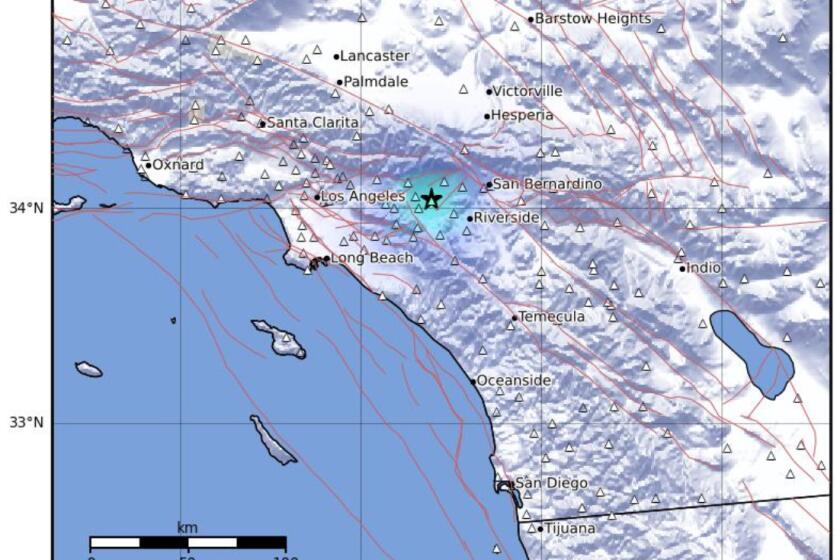How the Pros Get Quake-Ready
Talk about being prepared. Lucy Jones stopped mid-sentence while discussing earthquakes and pulled out a vibrating beeper from her hip, like a gunslinger.
“Just a three point in a mining area,” she noted from the display of the beeper, which relays information from computers monitoring earthquake activity.
Then Jones, best known to the L.A. public for her explanation of earthquakes during such emergencies, relaxed into a blue upholstered chair in her second-floor office in a 1926 Colonial-style house. The scientist in charge of the U.S. Geological Survey’s field office in Pasadena resumed explaining earthquake preparedness for office and home.
The 3,300-square-foot, two-story home, painted yellow with black shutters and white window trim, is located on the grounds of Caltech. The main downstairs hall is covered with a floor-to-ceiling California map, dotted with pins that mark stations where seismometers and other instruments detect ground motion.
A tour of the earthquake team’s home-away-from-home--few can forget the image of Jones with her 21-month-old-son, Niels, on her hip as she gave a televised news conference on the 1992 Landers earthquake--shows how the pros prepare for tremors.
Jones had the foundation of the house bolted. The bedrooms have been converted into offices. The living room is a conference room with a long wood conference table with 12 maroon upholstered chairs and a working gas fireplace with a key to the gas outlet kept close by at all times. Linda Curtis, the office information specialist, pointed out that the gas pipe is extra long and bent so it should be resistant to breaking.
Anything that can move--from computers to typewriters to bookshelves and file cabinets--is bolted down.
Securing bookcases, Jones pointed out, is a primary concern. The one directly behind her desk is attached to the wall with shock-absorbing straps.
“By using a nylon strap,” explained Tom Rundberg, president of Q-Safety Inc. of Duarte, “you eliminate the direct transference of an earthquake’s energy from the wall to the furniture” and thus dissipate the impact of the shaking.
In other words, if an L-bracket is used instead of a strap, a bookcase could either shake apart or tear off the wall, Jones said.
Her computer monitor has yet to be strapped down, but the CPU is secured with Velcro, inside a file cabinet drawer. As for a five-drawer metal file cabinet, Jones decided to place it in an area of her office where it won’t fall on anybody. The drawers, however, are always kept locked because they “can come flying out and really hurt people.” As for objects on her office walls, she requests plastic in lieu of glass in picture frames.
First-aid kits are stashed in bathrooms upstairs and downstairs. Jones said that nothing needs to be bolted in those particular rooms, except the porcelain top of a commode’s tank.
“These will fly off, but I’ve never figured out what you do about it.”
Fire extinguishers and battery operated flashlights hang side by side in halls, upstairs and down. They are attached with circle hooks with clasps to hold objects in place. Otherwise, objects hanging on open hooks can go flying in an earthquake. Rechargeable Coleman lanterns can be found in various rooms.
In the basement of the house, the boiler is strapped down and there’s even a small supply of bottled water down there. When I told Jones that I keep a five-gallon bottle of water in a closet but worry about not being able to get to the closet after an earthquake, Jones said: “Look, if your house is in the condition where you can’t get to your closet, you’re not staying in your home.” She added sympathetically: “Your house is probably going to be perfectly fine.”
Jones doesn’t seem that much concerned about food rations--and for good reason. After earthquakes, local restaurants take food to the field office.
On the main floor, a fully equipped office kitchen--with walls covered with pale yellow wallpaper with tiny pink and green flowers--includes a coffee maker for the staff. In the event of an earthquake, all kitchen appliances would continue to operate because of a generator--there mainly for the computers--at the house. The generator is tested annually.
Jones suggests that a certain measure of earthquake preparedness should be drawn from everyday supplies. Jones, who was born in Santa Monica, does that at her La Canada Flintridge home, which she shares with husband Egill Hauksson, a Caltech seismologist, and their two children.
There, the family’s Coleman lanterns and a stove--originally purchased and used for camping--doubles as emergency equipment. Jones stocks up on gas canisters during the end-of-the-summer sales.
Jones said that for herself, earthquake preparedness is about taking control because it makes one feel safer and psychologically more in control. The lack of control is what makes earthquakes so frightening.
“We are afraid of them out of proportion to the actual hazard that they pose to us.”
She recounted the time she went to Washington, D.C., for a meeting on natural hazards. Jones, who plays the viola, decided to indulge herself by going to a concert of medieval music. She got caught in a rainstorm while walking back to her Georgetown hotel and was soaking wet down to her underwear.
“And there was lightning. I mean, I watched it strike the street in front of me. I finally waited in a store for a while. You’re far more likely to be killed by lightning than by earthquakes.”
Candace A. Wedlan can be reached at candace.wedlan@latimes.com.
More to Read
Sign up for Essential California
The most important California stories and recommendations in your inbox every morning.
You may occasionally receive promotional content from the Los Angeles Times.










